Restoration of Westland Wessex HAS.3, XM328
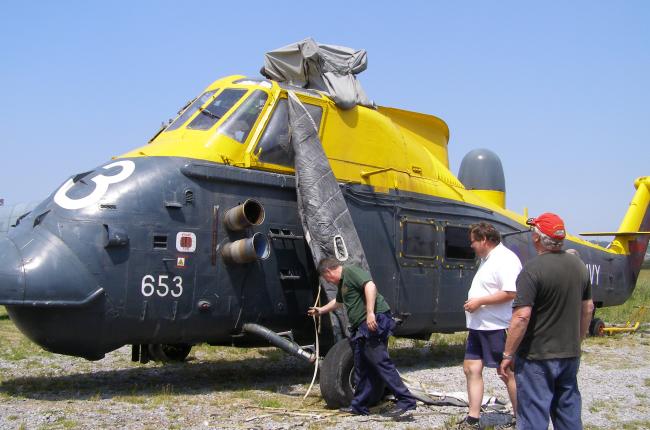
Wessex HAS.3 HistoryWestland Wessex, XM328, c/n WA9, was built at Yeovil in 1959 as a pre-production HAS.1 anti-submarine warfare helicopter for the Royal Navy, powered by one 1450 shp Napier Gazelle NGa.13 Mk.161 turboshaft engine. The HAS.1 was the world's first free-turbine engine aircraft to go into quantity production. It was fitted with dunking sonar, Doppler radar , partial auto-stabilisation and Louis Newmark Mk.19 autopilot facilities. The new Flight Control System allowed the HAS.1 to hover over the sea at night or in bad visibility. Previously this could only be done when the pilot had a visual horizon as a reference.XM328 spent the first years of its life engaged in radio, instrument and other flight performance trials, including some at A & AEE Boscombe Down with ten other pre-production examples. |
||
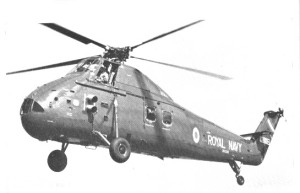 |
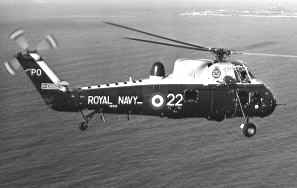 |
|
| Wessex HAS.1, XM328, in 1960 . | XM328 after HAS.3 configuration upgrade. | |
| Between 1965 and 1968 forty-three HAS.1s, including XM328, were upgraded to Mk.3 specification. This included a new Ekco search radar in a dorsal dome, causing the type to be known as the 'Camel', and full Louis Newmark Mk 30 duplex flight control systems giving attitude and heading control with barometric or radio altimeter height hold. A new medium-depth Plessey Type 195 dipping sonar system was fitted while the 1600 shp Gazelle NGa.22 Mk 165 turboshaft engine replaced the Mk 161 . | ||
| From 1970, XM328 was stationed at Portland, in Dorset, with 737 Naval Air Squadron
where, as an HAS.3, it was assigned to operate, in an operational training
role, from Helicopter Support Ship RFA Engadine and later,
from the stern platforms of several of the
six County Class guided missile destroyers, including HMS Glamorgan, HMS
Antrim and HMS Norfolk.
Wessex HAS.3s equipped seven flights on these destroyers in addition to an aircrew
training squadron at RNAS Portland. In
their ship-borne, anti-submarine role, the HAS.3s could carry two Mk.44 or Mk.46 homing
torpedoes (with parachutes) or four Mk.11 depth charges in addition to their Plessey
dipping sonar. They could also be fitted with a door-mounted machine gun and act as a
self-contained unit, handling all operations at the scene of an anti-submarine action. |
||
| In 1984, after a short time in storage at
Wroughton, XM328 was transferred to RNAS Culdrose, in Cornwall. There,
for the next twenty years,
it was used as a ground training aircraft, by the School of Aircraft Handling,
(more
recently, the School of Flight Deck Operations), which teaches the skills of moving and
securing aircraft on flight decks and in hangars. XM328 as seen (right) at RNAS Culdrose
in July 1997.
|
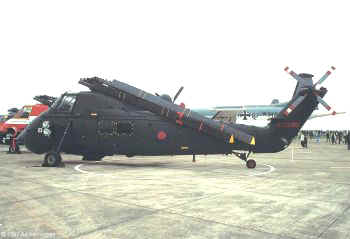 |
||
 |
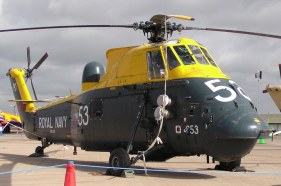 |
||
| In July 2003,
XM328, re-painted in anti-submarine colour scheme, was loaned, by RNAS Culdrose, for display at the Royal International Air Tattoo,
Fairford (above), but was declared surplus by the MoD, in early
2004, purchased by The Helicopter Museum, delivered by MASU in May 2004
and parked in the open air. Thanks for photographs (above left) © Stephen Boreham and (above right) © Ben Clements, both seen on Airliners.net |
|||
Restoration of the HAS.3 |
|||
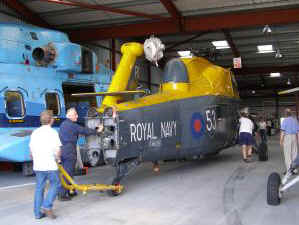 |
 |
||
| On 17th June 2006, after two years exposure to the weather, XM328 was brought into the main public Display Hangar (above) but, on 23rd June 2007, was transferred to the new engineering hangar area, not normally open to visitors, for conservation. However the HAS.3 could still be seen through the (normally open) hangar doorway, as work continued. | |||
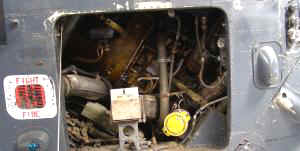 |
XM328 is largely complete although the instrument panel and a lot of the cockpit interior fittings were missing. Much of the cabin equipment survives, including some of the internal winch mechanism used for raising and lowering the sonar buoy. A rapid structural survey of the interior and exterior was carried out, in 2006, and the larger components of this cabin equipment were removed, for refurbishment and conservation, while the machine was still on public display in the main hangar. | ||
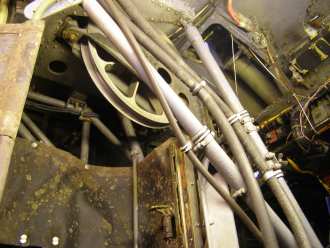 |
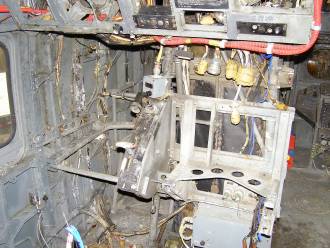 |
|
| Photographed in July 2006 (above left), before the cabin
equipment was removed, the sonar buoy cable pulley is seen in the
forward end of the cabin above the floor hatch. The remains of the sonar
operator's and the tactical observer's console (above right), in the centre of the
cabin and behind the sonar winch mechanism, retains the manual
control handle (centre of photograph) for the buoy hoist. The vacant space to the left of the console was occupied by the radar display, the panel to the right by the sonar screens and controls. |
||
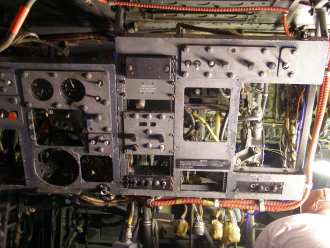 |
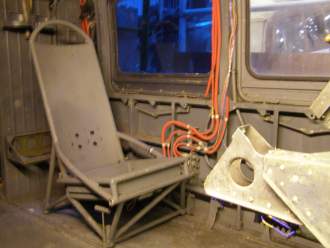 |
|
| Most of the autopilot, sonar and other avionics units, in the forward cabin racks, were labelled and removed in 2006, prior to cleaning and corrosion treatment. Following XM328's transfer to the newly-completed Engineering Hangar in 2007, most of the other cabin equipment was dismantled, though a control panel (above left) mounted above the console, and the radar operator's seat (above right), remained. | ||
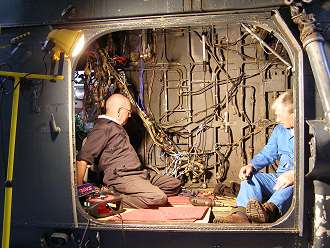 |
 |
|
| Restoration volunteers, Ray and Chris, taking a breather as work on stripping XM328's interior re-started in August 2007. | Tangled cables in XM328's cabin, in October 2007, as more of the anti-submarine sonar and radar equipment was being dismantled. | |
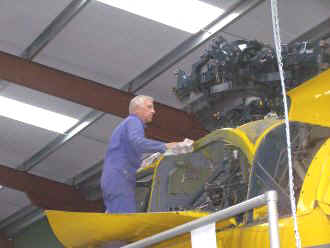 |
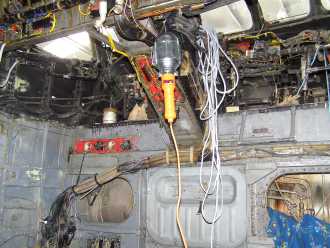 |
|
| Ken cleaned the outside of the aircraft to allow close examination of the skin. Removal of access panels allowed inspection of the transmission. | A view of the cockpit, looking forward and upward from the cabin, shows most of the controls and instruments to be missing. | |
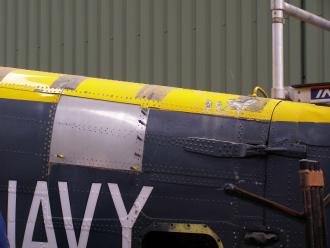 |
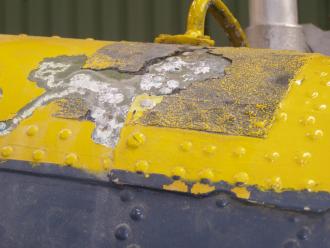 |
|
| In March 2008 work started on dealing with several panels where the light alloy skin of the semi- monocoque airframe, was showing serious corrosion. When this was minor the area was cleaned off and treatment applied before priming and re-painting. In most cases, however, the defective skin was removed and replacement panels were manufactured, drilled and riveted into place. | ||
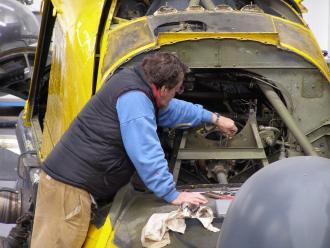 |
 |
|
| John removed the oil cooler assembly (above left), on 12th March 2008, before disconnecting the tail rotor drive shaft and rotor brake from the gearbox. It was decided that the transmission and rotor head should be removed from the deck to allow their refurbishment. Similarly the condition of the deck itself needed to be established. Fortunately a crane was still available and the big lift (above right) was performed on 12th April 2008. | ||
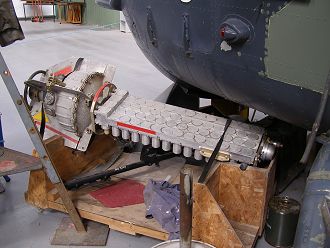 |
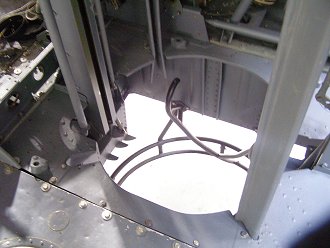 |
|
| Later in 2008 the incomplete sonar buoy (above left) was refurbished and work started on cleaning up the hole in the cabin floor (above right), below the winch, through which the buoy was lowered. Attempts to source a surplus winch mechanism are expected to bear fruit in November 2015. | ||
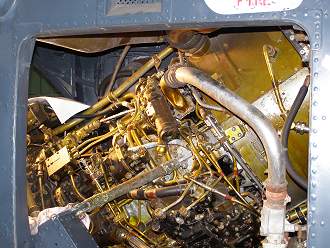 |
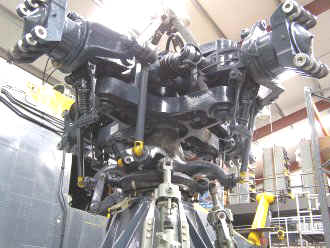 |
||
| The single Napier Gazelle engine, mounted in the nose (above left), was cleaned and refurbished in 2009. Removal was not thought to be necessary. The rotor head and main gearbox (above right), which had been removed in 2008, were thoroughly cleaned and then repainted. | |||
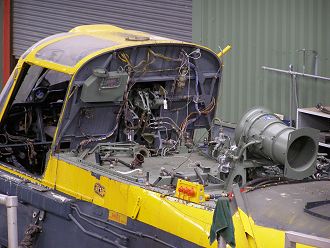 |
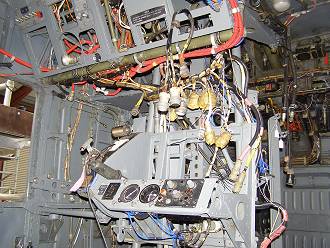 |
||
| After the gearbox and rotor head had been lifted off, the deck was cleaned and repainted (above left). Thorough cleaning and replacement of bearing components ensured that the head could turn freely. The oil cooler, other deck-mounted components and hydraulic pipe work, which had been removed in 2008, were cleaned and replaced. Unfortunately, while this refurbishment was being carried out in 2009, the Museum's veteran Coles crane had been declared unsafe to use and this resulted in a long delay to the replacement of gearbox and rotor head onto the deck. While suitable lifting equipment was sought the re-assembly of the surviving cabin ASW Doppler equipment (above right) was brought forward and the cabling was re-fitted. | |||
 |
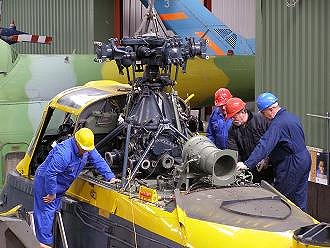 |
||
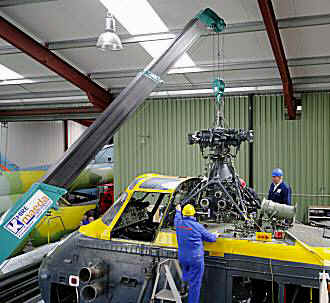 |
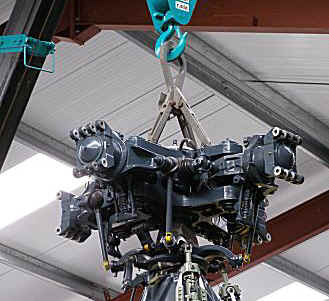 |
||
| In early 2010 Lee Mills, Museum General Manager, became aware of an opportunity to host a demonstration of the MAEDA MC305-2 mini crawler crane which was available from the nearby branch of Kranlyft UK. This offered the long-awaited chance to lift the refurbished gearbox and rotor head back onto the transmission deck of XM328, almost two years after its removal. The work was carried out, with impressive ease and efficiency, on 7th April 2010. | |||
 |
 |
||||
| After the main rotorhead and gearbox had been re-installed on 7th April 2010 the slow, methodical work of replacing hydraulic and mechanical connections to the deck-mounted components was undertaken. By early December 2010, most of the surrounding structure and covers had been replaced after anti-corrosion treatment and repainting. | |||||
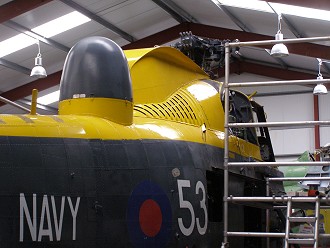 |
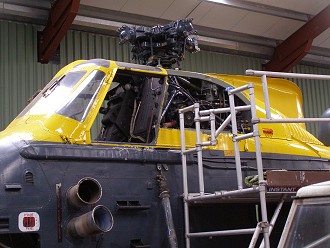 |
||||
| By 29th January 2011 the panels
and louvered fairings covering the tail rotor control servos and the
main rotor brake assembly had been refitted and painted along with the
dorsal radar antenna dome.
95% of the grey/blue paint, applied to the lower fuselage exterior, at RNAS Culdrose in 2002, remained in good condition and was retained. Only three small aluminium alloy fuselage panels were replaced where serious corrosion had been discovered in 2008. These panels were primed and painted with matching grey/blue. |
|||||
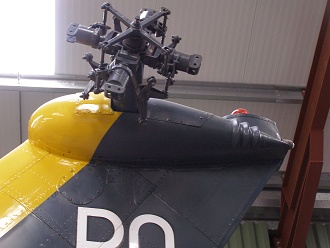 |
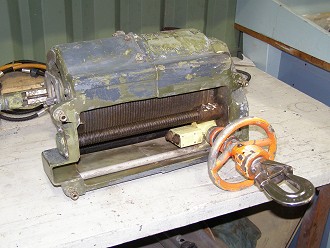 |
||||
| The tail rotorhead required minor refurbishing to remove rust patches before repainting in 2011. | An exterior electric winch was obtained in April 2012 but overhaul and painting was delayed. | ||||
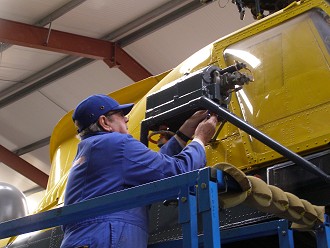 |
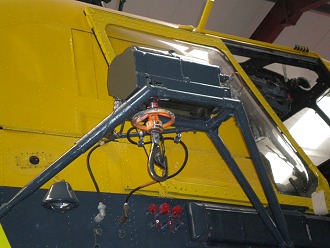 |
||||
| Work on XM328 had slowed considerably after some volunteer conservation staff temporarily moved across to visitor liaison duties, so it was not until December 2013 that refurbishment of the exterior electric winch was completed and final installation, above the cabin door, took place. | |||||
 |
 |
||||
| Arriving at The Museum in 2004, XM328's cockpit had no instrument panel (above left) but a panel was soon acquired and many instruments were obtained and fitted in the years up to 2015. (above right). | |||||
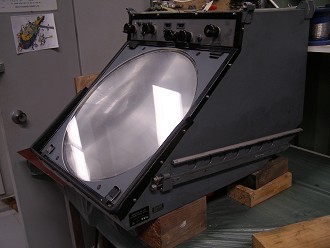 |
 |
||||
| A radar indicator unit was obtained in March 2014 (left) and fitted into the cabin control desk (right). | |||||
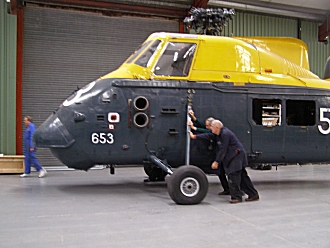 |
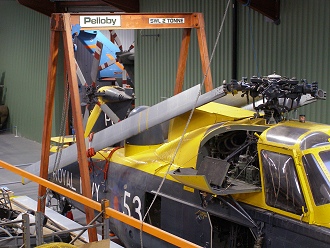 |
||||
| On 29th October 2014 XM328 was turned through 180 degrees so that the A-frame, with block-and- tackle, could be wheeled over the tail boom. This would allow the refurbished main rotor blades to be lifted and bolted to the main rotor head, in folded configuration. | |||||
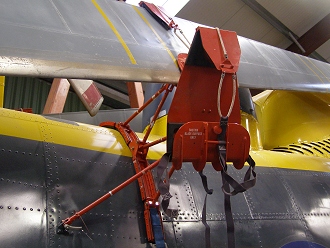 |
 |
||||
| In mid-November 2014 the main rotor blades were bolted to the rotor head and located on their respective supports. | A winch for the sonar winding gear was obtained from a Scottish museum in November 2015 and cleaned prior to installation in the cabin. | ||||
 |
|||||
| Wessex HAS.3, XM328, with restoration completed apart from some details of weapon fit, was returned to public display in February 2016 | |||||